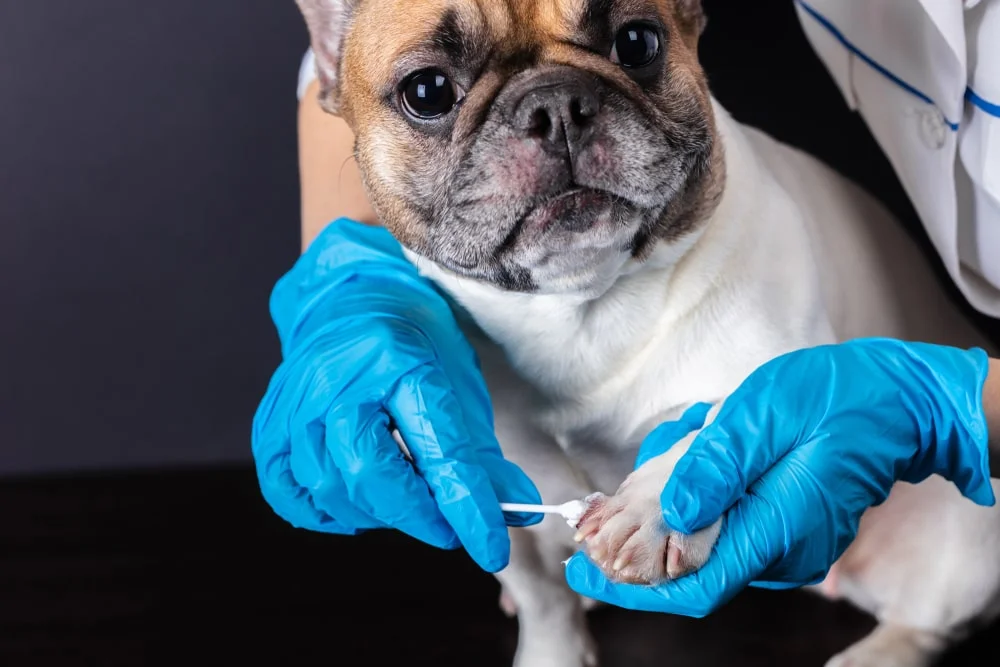PET HEALTH
Antibiotic ointments have been used by families for ages to treat minor wounds on human skin. So it may be tempting to reach into your medicine cabinet for your go-to ointment or cream of choice if your pup gets into a scrape. While Neosporin® is deemed safe for humans when used properly, can you put Neosporin on a dog or a cat?
Let’s go over everything you need to know about using Neosporin on dogs and other popular human wound ointments on your furry family.
What Is Neosporin?
Neosporin is the brand name for a topical antibiotic used to help treat and protect minor wounds.1 It contains three antibiotics — bacitracin, polymyxin, and neomycin — that help stop bacteria from growing in a wound, but they’re ineffective against fungi and viruses.2
Typically, Neosporin is used on scrapes, small cuts, and minor burns, but it shouldn’t be used over large portions of the skin.2 It’s an over-the-counter (OTC) medication you can get at most drugstores. If you prefer a generic version, look for packages that say triple antibiotic ointment.
Is Neosporin Safe for Dogs?
Neosporin is considered fairly safe to use on dogs.1 However, ingesting large amounts from licking it — or accidentally getting into the whole tube — can be harmful to your pup. This is because antibiotics can cause distress in a dog’s gastrointestinal tract and may trigger vomiting or diarrhea.3 Wrapping your dog’s wound or using an Elizabethan collar (cone) can help prevent them from licking Neosporin.
There’s also evidence that one of the antibiotics in Neosporin, neomycin, is linked to hearing loss in dogs, but it was given intravenously, not topically.3 Since Neosporin is a topical antibiotic, it’s considered safe, but it’s always a good idea to check with your veterinarian before using it.
Accidents Happen, Pet Insurance Can Help
When To Use Neosporin on Your Dog
Neosporin can be used safely on dogs when they have a minor cut, scrape, or burn. Once you’ve cleaned the wound with mild soap and water, you can place a small amount of Neosporin over the wound and take measures to prevent your dog from licking it off. If your dog’s wound is more severe, it’s a good idea to take them to your vet for treatment instead.3
If you’ve never used Neosporin on your dog, there’s a chance they may have an allergic reaction to it — just like any other topical treatment. You may want to test a small area before using it over the entire wound and watch for redness, hives, or a rash.3 Avoid using Neosporin around the ears, eyes, and internally.
Caring for a minor wound
Caring for minor wounds on your dog is fairly similar to treating minor wounds on yourself. With a scrape, small cut, or minor burn, gently clear away any debris you can see in or around it. Use a mild soap and warm water to clean the wound. You may need to safely clip any fur that’s in the way of the wound in order to clean it.
If your vet says it’s OK to use Neosporin, this is when you can apply a small amount. Depending on the location of the wound, you may be able to wrap it with a bandage or utilize an Elizabethan collar to prevent your dog from licking the Neosporin off. Your vet can tell you whether it’s a good idea to wrap the wound or leave it alone.
Alternatives to Neosporin for Dogs
Sometimes, it’s better to skip the human versions and opt for medications made specifically for dogs. Instead of Neosporin, you can use antimicrobial wound care sprays or chlorhexidine sprays or wipes made for pets. You may even be able to put manuka honey on the wound as an antibacterial — though you’ll likely need to wrap the honey-covered wound up so your dog doesn’t lick all the honey off.
If you’re unsure which products are right for your dog, talk with your vet to get their recommendations.
What Else Can You Put on a Dog Wound?
While Neosporin can be a safe choice to use on dog wounds, what happens if you don’t have any? Are there other ointments you can safely use to help your dog feel better? Let’s answer some of these questions.
Can you put AquaphorⓇ on your dog?
Yes. If your dog has a minor skin irritation, dry nose, or cracked paw pads, AquaphorⓇ can be used as a moisturizer.4 This petroleum jelly product is generally safe to use in small amounts. But just like Neosporin, it’s a good idea to prevent your dog from ingesting large amounts, as it can cause stomach upset.
Can you use Bacitracin on dogs?
Yes. Bacitracin is an antibiotic used to treat and prevent skin infections. Since it’s one of the three antibiotics included in Neosporin, it’s also deemed safe to use by itself on dogs.2 Just make sure your pup doesn’t ingest too much if they tend to lick.
Can you put VaselineⓇ on your dog?
Yes. Like Aquaphor, VaselineⓇ is a petroleum jelly product that can help protect dry skin, noses, or paw pads, as well as minor wounds.5 Small amounts are safe to use, just make sure your pup doesn’t ingest large quantities, since it can upset their stomach.
Can you use Bactine on dogs?
Yes. Bactine is an antibacterial spray that can be used safely on dogs in small amounts.7 It helps prevent infection and relieve itching and pain. However, one of the ingredients — lidocaine — can be harmful in large quantities, so ask your vet for their recommendation before using it.
Can you use PolysporinⓇ on dogs?
Yes. If you’re worried about using Neosporin on your pup because it contains neomycin, Polysporin® may be an option. Polysporin contains the other two antibiotics Neosporin does — so it’s essentially used for the same purpose — but without neomycin.7
Help Protect Your Pet and Wallet With Pet Insurance
Wounds can occur because of an accident. And while they may not always require a trip to the vet, what about more severe accidents or wounds? An unexpected trip to the emergency vet for wound care and treatment could cost $800 – $2,500 depending on where you live, the size of your dog, and their condition.8 Be financially prepared for accidents with the help of a dog insurance policy from MetLife Pet.
After meeting your deductible, you can get up to 90% of covered and approved expenses — like diagnostics, treatment, and medication — reimbursed.9 Get a free quote today and learn more about how pet insurance works to see if it’s right for you and your furry friend.
A MetLife Pet Policy May Help Cover Wound Treatment Costs
Dr. Hunter Finn has been paid by MetLife to discuss the importance of choosing pet insurance. He is an integrative veterinary expert first, and social media star second. America’s favorite veterinarian owns Pet Method in McKinney, Texas, where he cares for pets while prioritizing their emotional well-being. When he’s not at his clinic, he’s starring in viral videos on TikTok (2 million followers) and Instagram (500K followers) — where he’s been known to snuggle puppies and conquer the latest dance trends.


